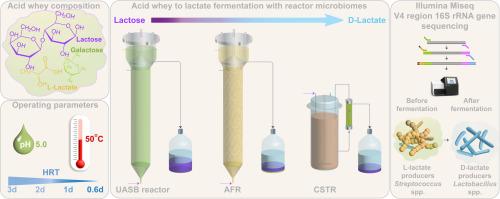从富含乳糖的废水生产乳酸:反应器配置的比较研究,以最大限度地提高转化率和效率
IF 12.4
1区 环境科学与生态学
Q1 ENGINEERING, ENVIRONMENTAL
引用次数: 0
摘要
大约90%的全球乳酸生产来源于细菌发酵糖通过纯同质发酵培养在批模式。酸乳清是酸奶工业产生的一种富含乳糖的废水,可以用作商业乳酸生产的替代底物。操作反应器微生物群通过规避灭菌降低了乳酸生产成本,而保留生物质的连续操作在更短的生产时间内实现了更高的生产率。为了找到从酸性乳清生产乳酸的最佳反应器配置,我们运行了三种不同的反应器配置:(1)上流式厌氧污泥膜(UASB)反应器;(2)厌氧过滤反应器(AFR);(3)具有中空纤维膜组件的厌氧连续搅拌槽式反应器(CSTR)。我们在不同的水力停留时间(hrt)下进行作业,以找到最佳的生产参数。我们没有使用接种物,但增加了内源性产生d -乳酸的乳杆菌,后来在反应器微生物群中占主导地位(>;90%的相对丰度)。未解离乳酸浓度大于60 mmol C L−1会抑制微生物群。我们通过缩短HRT至0.6天,并使用稀释的酸乳清底物(稀释1.67倍)来减轻抑制作用,以实现酸乳清糖几乎完全转化为乳酸。在0.6 d的HRT中,AFR和CSTR由于其更好的细胞保留能力而优于UASB反应器。在第365-384天期间,我们在CSTR系统的pH控制中出现了错误,pH值下降到4.3。在这个ph误差期之后,CSTR的乳糖和半乳糖转化为乳酸(LG-into-LA)的效率显著提高,超过了AFR。我们获得了最高的乳酸转化率1256±46.3 mmol C L−1 d−1(1.57±0.06 g L−1 h−1),乳酸转化为乳酸的转化效率为82.2±3.4%(以mmol C为单位),CSTR的产率为0.85±0.02 mmol C mmol C−1(每消耗底物的产物)。本文章由计算机程序翻译,如有差异,请以英文原文为准。


Lactate production from lactose-rich wastewater: A comparative study on reactor configurations to maximize conversion rates and efficiencies
About 90 % of global lactate production is derived from bacterial fermentation of sugars via pure homofermentative cultures in batch mode. Acid whey, which is a lactose-rich wastewater from the yogurt industry, can be used as an alternative substrate for commercial lactate production. Operating reactor microbiomes reduces the lactate production costs by circumventing sterilization, while continuous operation with biomass retention achieves higher productivity at shorter production times. To find the best reactor configuration with biomass retention for lactate production from acid whey, we operated three different reactor configurations: (1) an upflow anaerobic sludge blanket (UASB) reactor; (2) an anaerobic filter reactor (AFR); and (3) an anaerobic continuously stirred tank reactor (CSTR) with a hollow-fiber membrane module. We operated at different hydraulic retention times (HRTs) to find the optimum production parameters at a temperature of 50 °C and a pH of 5.0. We did not use an inoculum but enriched the endogenous D-lactate-producing Lactobacillus spp. that later dominated the reactor microbiomes (> 90 % relative abundance). Undissociated lactic acid concentrations of more than 60 mmol C L−1 inhibited the microbiomes. We alleviated the inhibition effect by shortening the HRT to 0.6 days and using diluted acid-whey substrate (1.67-fold dilution) to achieve almost complete conversion of the acid-whey sugars to lactate. At the 0.6-day HRT, the AFR and CSTR performed better than the UASB reactor due to their better cell retention abilities. During the period between Day 365–384, we experienced an error in the pH control of the CSTR system during which the pH value dropped to 4.3. After this pH-error period, the lactose and galactose-into-lactate (LG-into-LA) conversion efficiency for the CSTR considerably improved and surpassed the AFR. We achieved the highest lactate conversion rate of 1256 ± 46.3 mmol C L−1 d−1 (1.57 ± 0.06 g L−1 h−1) at a LG-into-LA conversion efficiency of 82.2 ± 3.4 % (in mmol C), with a yield of 0.85 ± 0.02 mmol C mmol C−1 (product per consumed substrate) for the CSTR.
求助全文
通过发布文献求助,成功后即可免费获取论文全文。
去求助
来源期刊

Water Research
环境科学-工程:环境
CiteScore
20.80
自引率
9.40%
发文量
1307
审稿时长
38 days
期刊介绍:
Water Research, along with its open access companion journal Water Research X, serves as a platform for publishing original research papers covering various aspects of the science and technology related to the anthropogenic water cycle, water quality, and its management worldwide. The audience targeted by the journal comprises biologists, chemical engineers, chemists, civil engineers, environmental engineers, limnologists, and microbiologists. The scope of the journal include:
•Treatment processes for water and wastewaters (municipal, agricultural, industrial, and on-site treatment), including resource recovery and residuals management;
•Urban hydrology including sewer systems, stormwater management, and green infrastructure;
•Drinking water treatment and distribution;
•Potable and non-potable water reuse;
•Sanitation, public health, and risk assessment;
•Anaerobic digestion, solid and hazardous waste management, including source characterization and the effects and control of leachates and gaseous emissions;
•Contaminants (chemical, microbial, anthropogenic particles such as nanoparticles or microplastics) and related water quality sensing, monitoring, fate, and assessment;
•Anthropogenic impacts on inland, tidal, coastal and urban waters, focusing on surface and ground waters, and point and non-point sources of pollution;
•Environmental restoration, linked to surface water, groundwater and groundwater remediation;
•Analysis of the interfaces between sediments and water, and between water and atmosphere, focusing specifically on anthropogenic impacts;
•Mathematical modelling, systems analysis, machine learning, and beneficial use of big data related to the anthropogenic water cycle;
•Socio-economic, policy, and regulations studies.
 求助内容:
求助内容: 应助结果提醒方式:
应助结果提醒方式:


